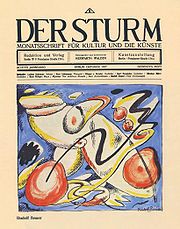
Herwarth Walden
Encyclopedia
Herwarth Walden was a German Expressionist artist and art expert in many disciplines. He is broadly acknowledged as one of the most important discoverers and promoters of German avant-garde art in the early twentieth century (Expressionism, Futurism, Dadaism, Magic Realism).
He studied composition and piano at the music academies of Berlin and Florence. But his interest embraced all arts. So he became a musician, composer, writer, critic, and gallery owner.
He was best known as the founder of the Expressionist magazine Der Sturm
(The Storm) and its offshoots. These consisted of a publishing house and journal, founded in 1910, to which he added an art gallery two years later.
He discovered, sponsored and promoted many young, still unknown artists of different styles and trends, such as the Blaue Reiter and Italian Futurism
. Later some of them became very famous: Oskar Kokoschka
, Maria Uhden, Georg Schrimpf
et al.
From 1901 to 1911 Walden was married to Else Lasker-Schüler
, the leading female representative of German Expressionist poetry. She invented for him the pseudonym "Herwarth Walden", inspired by Henry Thoreau’s novel Walden, or Life in the Woods
(1854).
In 1912, he married Swedish painter Nell Roslund.
In 1919, he became a member of the Communist Party
. In 1924, he was divorced from his second wife.
When the economic depressions of the 1930s, and the subsequent rise of National Socialism, compromised his activities.
In 1932, he married again and left after they were divorced, because of the threat of the Gestapo. He went to Moscow, where he worked as a teacher and publisher. His sympathies for the avant-garde soon aroused the suspicion of the Stalinist Soviet government, and he had to repeatedly defend against an equation of avant-garde and fascism.
Walden died in October 1941 in a Soviet prison in Saratov.
The finding of his death was found by the International Tracing Service
.

He studied composition and piano at the music academies of Berlin and Florence. But his interest embraced all arts. So he became a musician, composer, writer, critic, and gallery owner.
He was best known as the founder of the Expressionist magazine Der Sturm
Der Sturm
Der Sturm was a magazine covering the expressionism movement founded in Berlin in 1910 by Herwarth Walden. It ran weekly until monthly in 1914, and became a quarterly in 1924 until it ceased publication in 1932....
(The Storm) and its offshoots. These consisted of a publishing house and journal, founded in 1910, to which he added an art gallery two years later.
He discovered, sponsored and promoted many young, still unknown artists of different styles and trends, such as the Blaue Reiter and Italian Futurism
Futurism
Futurism was an artistic and social movement that originated in Italy in the early 20th century.Futurism or futurist may refer to:* Afrofuturism, an African-American and African diaspora subculture* Cubo-Futurism* Ego-Futurism...
. Later some of them became very famous: Oskar Kokoschka
Oskar Kokoschka
Oskar Kokoschka was an Austrian artist, poet and playwright best known for his intense expressionistic portraits and landscapes.-Biography:...
, Maria Uhden, Georg Schrimpf
Georg Schrimpf
Georg Schrimpf , was a German painter and graphic artist. Along with Otto Dix, George Grosz and Christian Schad, Schrimpf is broadly acknowledged as a main representative of the art trend Neue Sachlichkeit , which developed in the 1920s as a counter-movement to Expressionism and Abstraction...
et al.
From 1901 to 1911 Walden was married to Else Lasker-Schüler
Else Lasker-Schüler
Else Lasker-Schüler was a Jewish German poet and playwright famous for her bohemian lifestyle in Berlin. She was one of the few women affiliated with the Expressionist movement. Lasker-Schüler fled Nazi Germany and lived out the rest of her life in Jerusalem.-Biography:Schüler was born in...
, the leading female representative of German Expressionist poetry. She invented for him the pseudonym "Herwarth Walden", inspired by Henry Thoreau’s novel Walden, or Life in the Woods
Walden
Walden is an American book written by noted Transcendentalist Henry David Thoreau...
(1854).
In 1912, he married Swedish painter Nell Roslund.
In 1919, he became a member of the Communist Party
Communist party
A political party described as a Communist party includes those that advocate the application of the social principles of communism through a communist form of government...
. In 1924, he was divorced from his second wife.
When the economic depressions of the 1930s, and the subsequent rise of National Socialism, compromised his activities.
In 1932, he married again and left after they were divorced, because of the threat of the Gestapo. He went to Moscow, where he worked as a teacher and publisher. His sympathies for the avant-garde soon aroused the suspicion of the Stalinist Soviet government, and he had to repeatedly defend against an equation of avant-garde and fascism.
Walden died in October 1941 in a Soviet prison in Saratov.
The finding of his death was found by the International Tracing Service
International Tracing Service
The International Tracing Service in Bad Arolsen, Germany, is the internationally governed archive whose task it is to document the fate of millions of civilian victims of Nazi Germany. The documents in the ITS archives include original records from concentration camps, details of forced labour,...
.
Works

- Der Sturm (Magazine, 1910–1932)
- Dafnislieder für Gesang und Klavier (Songs, 1910)
- Das Buch der Menschenliebe (Novel, 1916)
- Die Härte der Weltenliebe (Novel, 1917)
- Kind (Drama, 1918)
- Menschen (Drama, 1918)
- Unter den Sinnen (Novel, 1919)
- Die neue Malerei (Essays, 1920)
- Glaube (Drama, 1920)
- Einblick in Kunst (Essay, 1920)
- Sünde (Drama, 1920)
- Die Beiden (Drama, 1920)
- Erste Liebe (Drama, 1920)
- Letzte Liebe (Drama, 1920)
- Im Geschweig der Liebe (Poems, 1925)
- Vulgär-Expressionismus (Essay, 1938)
External links
- "Herwarth Walden", Deutsches Wikipedia
- "Herwarth Walden. Ein Essayist der Moderne", Paleari, Moira, Amsterdamer Beiträge zur neueren Germanistik

